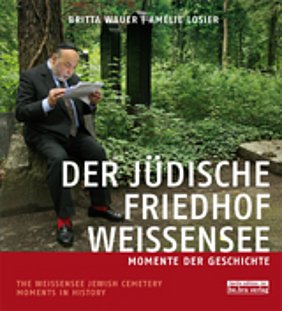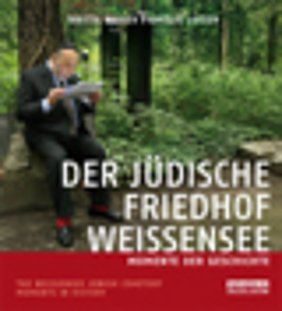Today it still links people and destinies from all over the world: the surgeon from Israel whose grandparents lie buried here; the family from South America, who wanted to make money out of the mausoleum of their rich ancestors; the man who as a 14 year old had sport lessons among the graves and fell in love with one of his fellow pupils; or the little family who live in the cemetery today.
In this book Britta Wauer has assembled photographs and stories from the past and the present of this fascinating place and gives the reader a unique insight into Jewish life in Germany from 1880 until today.
Contains over 140 historic and current photographs with text in both German and English.
Amélie Losier, Britta Wauer:
Der jüdische Friedhof Weißensee / The Weissensee Jewish Cemetery
Momente der Geschichte / Moments in History
be.bra Verlag, Berlin 2011
ISBN 978-3-8148-0172-8
176 Pages, 135 partially coloured illustrations
Introduction
On the map it looks like a Renaissance garden; a geometric pattern of rectangles, trapeziums and triangles. The avenues criss-cross each other in circles and squares. But when you enter the grounds you feel you have stepped into a place of enchantment.
Morning dew and mist, high trees and thickets. Among them are columns, stones, mausoleums, ivy, lilac and a small fox running across the path – the Weissensee Jewish Cemetery. It was the third one since the Middle Ages to be laid down by the Jewish community of Berlin. It is 130 years old and the largest Jewish cemetery in Europe still in use. It could accommodate about 86 football pitches.
Yet hardly a sightseeing bus comes off the tourist track to head for the cemetery. Only few people are aware that the cemetery grounds are classified as a historical monument and in a few years will hopefully be an official UNESCO World Heritage Site. The significance of the cemetery lies not only in its extraordinary graves, whose variety and splendour today seem almost incredible, but also its fate which is so closely entwined with that of Berlin. When you explore the cemetery on foot, it is like walking through a history book. The list of famous artists, philosophers, lawyers, architects, doctors, religious teachers and publishers who are buried there is endless. The department store founders Adolf Jandorf (KaDeWe) and Hermann Tietz (Hertie) are among them, the artist Lesser Ury, the publisher Samuel Fischer (S. Fischer Verlag), Berthold Kempinski, who gave his name to the famous luxury hotel chain and Rudolf Mosse, who once owned the largest publishing house in Europe. However, the very first person to be buried there on 22nd September 1880 was not a celebrity, but Louis Gruenbaum, the former director of an old peoples’ home. On the side of his gravestone is a large number “1”. The fact that the stone is still standing is because a Jewish cemetery is created for eternity. The graves are not levelled and there are no expiry dates. On every gravestone in Weissensee there is a sequential number and the fresh graves have six-figure numbers. Over 115,000 people are buried in the cemetery. Simple headstones stand alongside splendid Mausoleums from the art nouveau or Art deco eras. Some graves were designed by Bauhaus architects Ludwig Mies van der Rohe und Walter Gropius. Some of them seem fanciful, others have moving inscriptions, others impress with their monumental style. Yet, although the money available to spend on the creation of each grave must have varied enormously at the time, today they are similar; crumbling, overgrown, forgotten. In summer hardly a ray of light can pierce the massive treetops to reach down on to the graves. Some paths are so overgrown that it seems as if it were years since anyone has forced their way through to the graves. There are hardly any relatives who can look after the graves. The Holocaust did not only destroy the lives of millions but also destroyed the memory of them. In the 1930s there were 170,000 Jews living in Berlin, at the end of the war only 5,000 remained.
What is special about Weissensee is that it was never closed. The cemetery belonged to the few institutions in Germany which remained under Jewish administration during the Nazi period. Jewish children played in Weissensee when it became too dangerous for them on the streets of Berlin. Here they nibbled on plums and apricots from wild fruit trees. Some individuals hid from their persecutors here for a few nights in freshly dug graves or in mausoleums. From 1943 to 1945 Rabbi Martin Riesenburger even conducted funerals – all of them according to Jewish tradition, except that Riesenburger and his remaining staff were the only ones who were able to follow the coffin to the grave.
Some graves relate what became of the Berlin Jews: headstones on which the parents share the same date of death as their children suggest suicide. Gravestones with blank spaces which have remained empty tell of people for whom a place was reserved but who were never buried because they were murdered in a concentration camp. Sometimes we discover their names. Now and then on family graves there is an additional inscription: “In memory of …”.
Situated on the outskirts of the capital of the GDR, after the war the cemetery fell into further oblivion. It was not possible for the little East Berlin community to control the spreading wilderness in Weissensee. In their helplessness the administration decided at that time to leave the main part of the cemetery to nature in order to have the strength and means to at least have a few representative plots in the entrance area where burials could still take place. Since reunification the cemetery staff is trying to restore the individual plots one by one.
With over 12,000 members the Jewish community in Berlin is today the largest in Germany. This is mainly due to the number of Jews who have immigrated from the former Soviet Union; they account for about 80% of the community. The customs and traditions which these families have brought from their old homeland are the latest and most exciting chapter in Weissensee because funerals are still taking place in these historic grounds.
What we find in Weissensee cemetery is not only Jewish history, but at the same time the history of Berlin and Germany – and it is still continuing.



